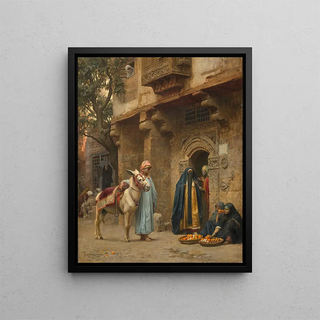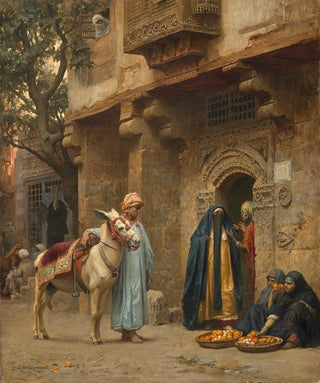Art print | Arab women in front of a door - Frederick Arthur Bridgman


View from behind

Frame (optional)
In the fascinating world of art, some works transcend their era to capture the collective imagination. "Arab Women in Front of a Door" by Frederick Arthur Bridgman is a perfect example. This canvas, imbued with an enchanting atmosphere, transports us to a world where the beauty of Arab women blends with traditional architecture. The artist, through his gaze, invites us to explore a rich and complex culture, while awakening our curiosity about the stories hidden behind each face and every detail. The scene, bathed in light, reveals not only the grace of the female figures but also the essence of a daily life filled with mystery and poetry.
Style and uniqueness of the work
Bridgman, master of realism and impressionism, deploys here a style that is uniquely his own. The color palette chosen evokes warm, earthy tones, creating a striking contrast with the scene’s brightness. The drapery of the women’s clothing, carefully rendered, testifies to meticulous attention to detail. Every fold, every shadow seems to tell a story, adding a tactile dimension to the piece. The background, with its ornate door, suggests a passage to an inner world, while remaining a symbol of Eastern culture. The composition, balanced and harmonious, guides the viewer’s eye toward the central figures, while hinting at the subtleties of the environment. This work is not merely a visual representation; it evokes an atmosphere, a sensation, an invitation to escape.
The artist and his influence
Frederick Arthur Bridgman, 19th-century American artist, established himself as a pioneer in the depiction of the Orient. His career is marked by a deep interest in exotic cultures, which he discovered during his travels in North Africa and the Middle East. These experiences profoundly influenced his art, allowing him to capture authentic and vibrant scenes of life. Bridgman does not limit himself to reproducing stereotypes; he seeks to understand and portray the reality of the peoples he has encountered. His work, rich in detail and emotion, has contributed to awakening

Matte finish

View from behind

Frame (optional)
In the fascinating world of art, some works transcend their era to capture the collective imagination. "Arab Women in Front of a Door" by Frederick Arthur Bridgman is a perfect example. This canvas, imbued with an enchanting atmosphere, transports us to a world where the beauty of Arab women blends with traditional architecture. The artist, through his gaze, invites us to explore a rich and complex culture, while awakening our curiosity about the stories hidden behind each face and every detail. The scene, bathed in light, reveals not only the grace of the female figures but also the essence of a daily life filled with mystery and poetry.
Style and uniqueness of the work
Bridgman, master of realism and impressionism, deploys here a style that is uniquely his own. The color palette chosen evokes warm, earthy tones, creating a striking contrast with the scene’s brightness. The drapery of the women’s clothing, carefully rendered, testifies to meticulous attention to detail. Every fold, every shadow seems to tell a story, adding a tactile dimension to the piece. The background, with its ornate door, suggests a passage to an inner world, while remaining a symbol of Eastern culture. The composition, balanced and harmonious, guides the viewer’s eye toward the central figures, while hinting at the subtleties of the environment. This work is not merely a visual representation; it evokes an atmosphere, a sensation, an invitation to escape.
The artist and his influence
Frederick Arthur Bridgman, 19th-century American artist, established himself as a pioneer in the depiction of the Orient. His career is marked by a deep interest in exotic cultures, which he discovered during his travels in North Africa and the Middle East. These experiences profoundly influenced his art, allowing him to capture authentic and vibrant scenes of life. Bridgman does not limit himself to reproducing stereotypes; he seeks to understand and portray the reality of the peoples he has encountered. His work, rich in detail and emotion, has contributed to awakening






